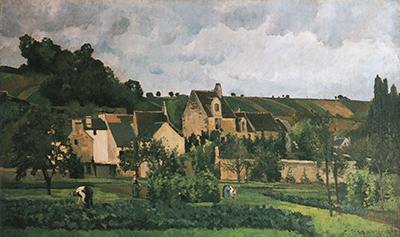The Hermitage at Pontoise is one of Camille Pissarro's most celebrated works. Rendered in oil on canvas, the image shows a winding country lane leading towards a village, with a few people in pesant dress walking along the lane or standing in the foreground as if they'd stopped to speak.
By the time The Hermitage at Pontoise was painted (c.1867), Pissarro had established his striking trademark style. The setting is picturesque and beautiful, but presented in a clear and unsentimental manner. The picture represents a significant contribution to the genre of realism: details such as the peasants' clothing, the load carried by one woman on her head, the tired children resting in the grass, all create a strong impression of everyday life.
Pissarro's predecessors tended to select historical subjects for their works, or at least to include historical overtones. When contemporary scenes were the subject, they tended to be romanticised and given a sentimental gloss. Pissarro set himself staunchly against these conventions, choosing instead to paint contemporary life in a manner that celebrated his subjects without idealising them or eliding the hardships of their lives. At the time, some critics decried the representation of "lower-class" people as vulgar; Pissarro's defiant insistance in capturing the rugged lives of ordinary people can be seen as quite revolutionary for the period.
While The Hermitage at Pontoise is thoroughly informed by conventions established by the Barbizon school of art, it is not constrained by them. We can see Pissarro's masterful use of light and shade, as well as a vivid use of colour. Pissarro perfectly captures the subtle tones of the stonework making up the buildings, the verdant greenery, the earthy tones of the fields. At the time, Pissarro had been working closely with notable landscape painters such as Claude Monet and Pierre Auguste Renoir; we can see the influence of these painters in Pissarro's use of colour to depict natural forms such as the flowers and trees.
The painting is a triumph of Realism; yet at the same time, it also represents the point at which Pissarro became dissatified with the Realist genre of painting and began to move away from it. (Caillebotte famously had a style which combined realism and impressionism together). Pissarro's later works are distinctly different, with a much looser and freer style. Here, the brushwork is quite compact and meticulous, with small patches of paint and very defined forms. This contrasts with Pissarro's later works, where the strokes of his brush or pastel become charged with a sweeping energy; instead of defining physical elements as in The Hermitage at Pontoise, the forms and colours seen in works such as 1881's The Conversation are far more impressionistic. In some works, such as 1887's Children on a Farm, Pissarro embraced a pointilistic style; he was to step away from this, however, and develop a technique using broader strokes. Pissarro continued to paint and develop his style until his death in 1903.




